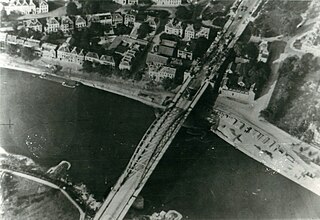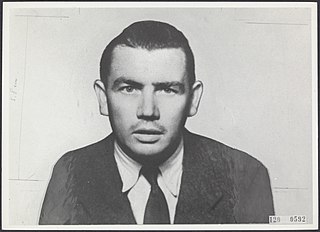Related Research Articles

Operation Market Garden was an Allied military operation during the Second World War fought in the Netherlands from 17 to 25 September 1944. Its objective was to create a 64 mi (103 km) salient into German territory with a bridgehead over the River Rhine, creating an Allied invasion route into northern Germany. This was to be achieved by two sub-operations: Seizing nine bridges with combined U.S. and British airborne forces (Market) followed by land forces swiftly following over the bridges (Garden).

Airborne forces are ground combat units carried by aircraft and airdropped into battle zones, typically by parachute drop or air assault. Parachute-qualified infantry soldiers serving in airborne force are also known as paratroopers.

The Battle of Arnhem was a battle of the Second World War at the vanguard of the Allied Operation Market Garden. It was fought in and around the Dutch city of Arnhem, the town of Oosterbeek, the villages Wolfheze and Driel and the vicinity from 17 to 26 September 1944. The Allies were poised to enter the Netherlands after sweeping through France and Belgium in the summer of 1944, after the Battle of Normandy. Operation Market Garden was proposed by Field Marshal Sir Bernard Montgomery, who favoured a single push northwards over the branches of the Lower Rhine River, allowing the British Second Army to bypass the Siegfried Line and attack the Ruhr. US Airborne troops were dropped in the Netherlands to secure bridges and towns along the line of the Allied advance. Farthest north, the British 1st Airborne Division landed at Arnhem to capture bridges across the Nederrijn, supported by men of the Glider Pilot Regiment and the 1st Polish Parachute Brigade. The British XXX Corps were expected to reach the British airborne forces in two to three days.

Operation Pegasus was a military operation carried out on the Lower Rhine near the village of Renkum, close to Arnhem in the Netherlands. Overnight on 22–23 October 1944, the Allied military forces, MI9, the British intelligence organization, and the Dutch Resistance successfully evacuated 138 men, mostly soldiers trapped in German-occupied territory who had been in hiding since the Battle of Arnhem.

The 1st Airborne Division was an airborne infantry division of the British Army during the Second World War. The division was formed in late 1941 during the Second World War, after the British Prime Minister, Winston Churchill, demanded an airborne force, and was initially under command of Major-General Frederick A. M. Browning. The division was one of two airborne divisions raised by the British Army during the war, with the other being the 6th Airborne Division, created in May 1943, using former units of the 1st Airborne Division.

Major General Robert Elliot "Roy" Urquhart, was a British Army officer who saw service during the Second World War and Malayan Emergency. He became prominent for his role as General Officer Commanding the 1st Airborne Division, which fought with great distinction, although suffering very severe casualties, in the Battle of Arnhem during Operation Market Garden in September 1944.

Operation Jedburgh was a clandestine operation during World War II in which three-man teams of soldiers of the British Special Operations Executive (SOE), the U.S. Office of Strategic Services (OSS), the Free French Bureau Central de Renseignements et d'Action and the Dutch and Belgian armies in exile were dropped by parachute into occupied France, the Netherlands and Belgium. The objective of the Jedburgh teams was to assist allied forces who invaded France on 6 June 1944 with sabotage and guerrilla warfare, and leading local resistance forces in actions against the Germans.

XXX Corps was a corps of the British Army during the Second World War. The Corps was formed in the Western Desert in September 1941. It provided extensive service in the North African Campaign and many of its units were in action at the Second Battle of El Alamein in late 1942. It then took part in the Tunisia Campaign and formed the left flank during the Allied invasion of Sicily in 1943.

The First Allied Airborne Army was an Allied formation formed on 2 August 1944 by the order of General Dwight D. Eisenhower, the Supreme Allied Commander of the Allied Expeditionary Force. The formation was part of the Allied Expeditionary Force and controlled all Allied airborne forces in Western Europe from August 1944 to May 1945. These included the U.S. IX Troop Carrier Command, the U.S. XVIII Airborne Corps, which controlled the 17th, 82nd and 101st Airborne Divisions and a number of independent airborne units, all British airborne forces including the 1st and 6th Airborne Divisions plus the Polish 1st Parachute Brigade.

Operation Anger, was a military operation to seize the city of Arnhem in April 1945, during the closing stages of the Second World War. It is also known as the Second Battle of Arnhem or the Liberation of Arnhem. The operation was part of the Canadian First Army's liberation of the Netherlands and was led by the 49th British Infantry Division, supported by armour of the 5th Canadian Armoured Division, Royal Air Force air strikes and boats of the Royal Navy.
Operation Berlin was a night-time evacuation of the remnants of the beleaguered British 1st Airborne Division, trapped in German-occupied territory north of the Lower Rhine in the Netherlands during Operation Market Garden in the Second World War. The aim of the operation was to withdraw safely the remnants of the division while covered by the 1st Polish Parachute Brigade and surrounded on three sides by superior German forces and in danger of being encircled and destroyed.

The Arnhem Oosterbeek War Cemetery, more commonly known as the Airborne Cemetery, is a Commonwealth War Graves Commission cemetery in Oosterbeek, near Arnhem, the Netherlands. It was established in 1945 and is home to 1764 graves from the Second World War besides 4 later non-war graves and there are special memorials of two personnel buried elsewhere. Most of the men buried in the cemetery were Allied servicemen killed in the Battle of Arnhem, an Allied attempt to cross the Rhine in 1944, or in the liberation of the city the following year. Men killed in these battles are still discovered in the surrounding area even in the 21st century, and so the number of people interred in the cemetery continues to grow.

Christiaan Antonius Lindemans was a Dutch double agent during the Second World War, working under Soviet control. Otherwise known as Freddi Desmet, a Belgian army officer and SOE agent with security clearance at the Dutch Military Intelligence Division of the SOE (MID/SOE). He is better known under his nickname "King Kong" or in some circles as "le Tueur" as he undertook missions to kill and was ready to shoot at the slightest provocation. There is speculation that Lindemans was a member of Colonel Claude Dansey's Z organisation.

The 1st Airlanding Light Regiment was an airborne forces unit of the British Army's Royal Artillery during the Second World War.
Lykele Faber, also given as Lijkele Faber was a Dutch commando and radio operator during World War II. He took part in the Battle of Arnhem and helped organize the Dutch resistance. In recognition of his services, Faber was decorated with the Dutch Bronze Cross (1945) and Cross of Merit (1945) and the British King's Medal for Courage in the Cause of Freedom (1947), among others.

Theodore Herman Bachenheimer a.k.a. Theodor Storm,, was an American soldier. In just three years, he achieved legendary status as one of the war's most daring reconnaissance scouts, he was better known as The Legendary Paratrooper or The G.I. General and was befriended by Martha Gellhorn.
Leonard Richard Douglas Willmott, MM, BEM was a British soldier who saw active service as a signaller with the Special Operations Executive during World War II. Willmott joined the British Army whilst in his teens and rose through the ranks to gain a commission. He saw active service with distinction in Europe, including Poland in September 1939, and was awarded British, French and Dutch decorations. After his British Army service was terminated, Willmott emigrated to New Zealand where he worked in various parts of the security services.

The Battle of Nijmegen or Liberation of Nijmegen occurred in the Netherlands from 17 to 20 September 1944, as part of Operation Market Garden during World War II.

The Battle of the Nijmegen salient or the Defence of the Nijmegen bridgehead was a series of engagements that took place in the Netherlands during World War II between 30 September and 8 October 1944. The battle occurred in the aftermath of Operation Market Garden, a failed attempt by the Allies to cut off German forces in the Netherlands and end the war quickly.
References
- 1 2 3 Simpson, John (1993), The Quiet Operator, Pen & Sword Books, pp. 159–161
- ↑ Th Peelen & Ab L. J. van Vliet, Zwevend naar de dood, Van Holkema & Warendorf, 1977 (Dutch)
- ↑ Simpson, John (1993), The Quiet Operator, Pen & Sword Books, pp. 100–101
- ↑ Major Robert G. Gutjahr, "The Role of Jedburgh Teams in Operation Market Garden", thesis, U.S. Army Command and General Staff College, Fort Leavenworth, 1990